 Server
Colocation
Server
Colocation
 CDN
Network
CDN
Network
 Linux Cloud
Hosting
Linux Cloud
Hosting
 VMware Public
Cloud
VMware Public
Cloud
 Multi-Cloud
Hosting
Multi-Cloud
Hosting
 Cloud
Server Hosting
Cloud
Server Hosting
 Kubernetes
Kubernetes
 API Gateway
API Gateway

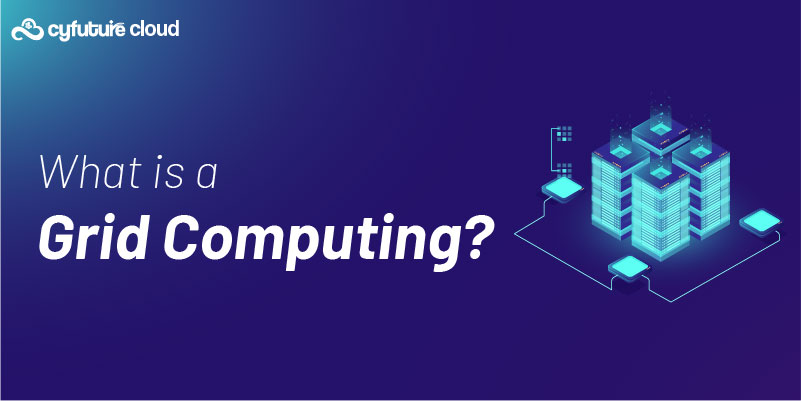
Grid computing is a type of distributed computing that harnesses the power of multiple computers, often spread across various locations, to work together on complex tasks. It involves pooling resources from multiple independent machines, effectively creating a virtual supercomputer that can handle large-scale computational tasks more efficiently. By breaking down a problem into smaller parts and distributing those parts across the network of computers, grid computing makes it possible to complete tasks faster and with greater accuracy than a single machine could handle.
This technology has revolutionized fields like scientific research, financial modeling, and big data analysis by enabling organizations to tap into a wide array of computing power without having to invest in massive hardware infrastructure.
At its core, grid computing works by connecting computers and allowing them to share processing power, memory, storage, and data. These interconnected systems, often referred to as nodes, work in parallel to execute tasks or solve complex problems. Each node contributes to the overall computation based on its available resources.
Key Components of Grid Computing:
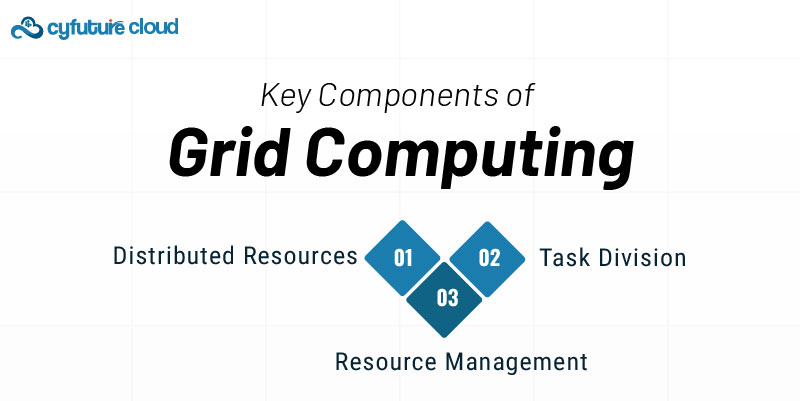
Distributed Resources: Unlike traditional supercomputers, grid computing doesn't rely on a single centralized machine. Instead, it involves various distributed resources that might be located in different geographic locations.
Task Division: The primary task or problem is divided into smaller, more manageable chunks. Each node on the grid is responsible for processing one or more chunks of the task.
Resource Management: A middleware layer handles the coordination between the nodes, ensuring that resources are efficiently utilized. This middleware is responsible for managing tasks, handling communication between nodes, and ensuring proper load balancing.
There are several types of grid computing based on the specific needs and usage scenarios:

A computational grid focuses on processing power, where tasks that require extensive computation are distributed across a network of machines. This type of grid is particularly useful for scientific simulations, weather modeling, and other CPU-intensive tasks.
A data grid deals with large amounts of data. It allows for the storage, management, and processing of massive datasets across distributed networks. Data grids are commonly used in fields like scientific research, where huge datasets (such as those generated by the Large Hadron Collider) need to be processed and analyzed.
A collaboration grid enables different organizations to share resources and work on projects together. This is often seen in academic research or industries where collaboration across different entities is necessary. Multiple organizations can pool their resources, whether computing power or data, to achieve a common goal.
Utility grids offer computing resources on-demand, similar to a utility service (such as electricity or water). Organizations can access additional computational power when needed and pay for the resources used. This type of grid computing is especially relevant in the era of cloud computing.
Grid computing is used in a wide range of industries and sectors. Here are some notable examples:
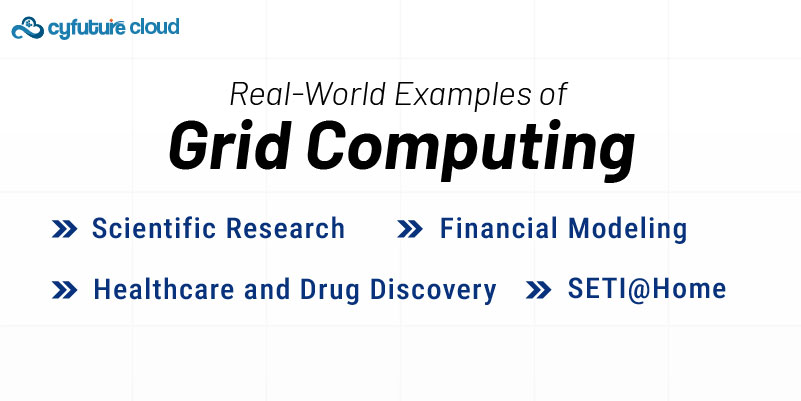
One of the most famous uses of grid computing is in the scientific community, particularly in large-scale physics experiments like the Large Hadron Collider (LHC) operated by CERN. The LHC generates massive amounts of data that need to be processed and analyzed. Grid computing allows scientists worldwide to collaborate by contributing their computational resources to handle these enormous datasets.
In the financial industry, grid computing is used for risk analysis, financial forecasting, and real-time trading simulations. Financial institutions, like investment banks, rely on grid computing to quickly process and analyze vast amounts of financial data, enabling them to make more informed decisions in less time.
In the medical field, grid computing has been used to model molecular structures, simulate drug interactions, and even analyze genetic data. This is particularly useful in the drug discovery process, where researchers can test the effectiveness of different compounds more quickly by leveraging distributed computing resources.
SETI@Home is a well-known example of a public grid computing project. The project allows volunteers to donate unused processing power from their personal computers to analyze radio signals from space in the search for extraterrestrial intelligence. The project's success lies in its ability to aggregate processing power from millions of individual machines to tackle a monumental task.
Grid computing offers numerous benefits to organizations, developers, and researchers. Some of the key advantages include:
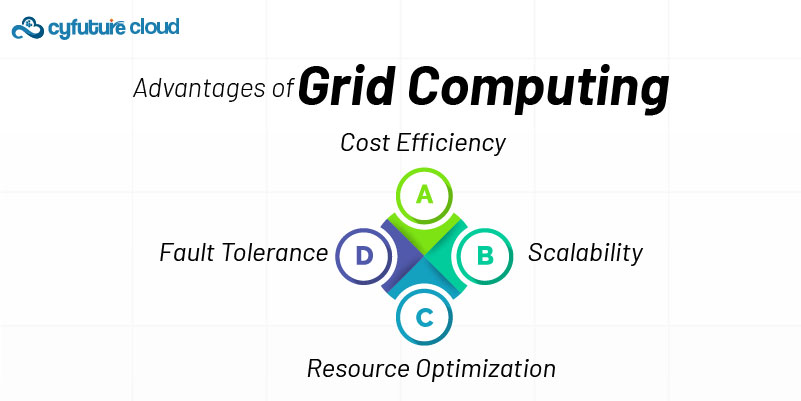
Grid computing enables organizations to utilize existing resources rather than investing in expensive hardware. By pooling together resources from different locations, organizations can achieve the computing power of a supercomputer without the associated costs.
One of the major strengths of grid computing is its scalability. As more computational power is needed, additional computers can be added to the grid without the need for significant infrastructure changes. This makes grid computing an attractive solution for projects that need to scale quickly.
In traditional computing setups, many machines may have underutilized resources, such as CPU or memory. Grid computing allows organizations to maximize the use of these idle resources, making their systems more efficient.
Because grid computing is distributed, it can handle node failures without disrupting the entire task. If one node goes offline, other nodes in the grid can take over, ensuring that the task continues without interruption.
While grid computing offers many advantages, it is not without its challenges. Some of the limitations include:
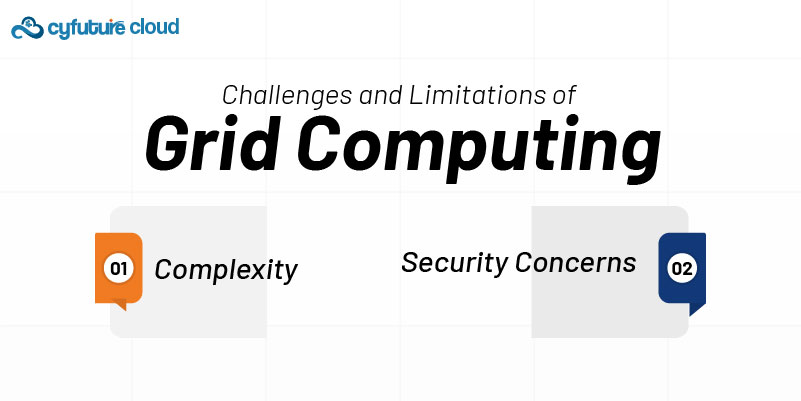
Setting up a grid computing network can be complex, especially when dealing with distributed resources in different locations. Managing the middleware, resource allocation, and task scheduling requires significant expertise.
Grid computing often involves sharing resources across different organizations or entities, which raises security concerns. Ensuring that sensitive data is protected while being processed on different machines is a major challenge.
Grid computing networks often consist of different types of machines with varying hardware configurations, operating systems, and software environments. This heterogeneity can make it difficult to ensure smooth operation across the grid.
Grid computing is often compared to cloud computing, as both involve distributed computing models. However, there are some key differences between the two:
Resource Ownership: In grid computing, resources are often contributed by multiple organizations or individuals, while in cloud computing, resources are typically owned and managed by a single cloud provider.
On-Demand Availability: Cloud computing offers resources on demand, allowing users to scale up or down as needed. Grid computing, on the other hand, typically involves a predefined set of resources that are shared for specific tasks.
Focus: Grid computing is often used for large-scale scientific or technical tasks that require extensive computational power, whereas cloud computing is used for a broader range of services, from hosting websites to running business applications.
Grid computing is a powerful technology that allows organizations to pool resources and tackle large-scale computational problems. By distributing tasks across a network of computers, grid computing enables faster processing, cost savings, and resource optimization. Although it comes with some challenges, such as complexity and security concerns, its advantages in scalability and efficiency make it an essential tool for scientific research, financial modeling, and many other fields.

Let’s talk about the future, and make it happen!
By continuing to use and navigate this website, you are agreeing to the use of cookies.
Find out more


